Cite this document
(Finance project Statistics Example | Topics and Well Written Essays - 2000 words, n.d.)
Finance project Statistics Example | Topics and Well Written Essays - 2000 words. https://studentshare.org/finance-accounting/1871698-finance-project
Finance project Statistics Example | Topics and Well Written Essays - 2000 words. https://studentshare.org/finance-accounting/1871698-finance-project
(Finance Project Statistics Example | Topics and Well Written Essays - 2000 Words)
Finance Project Statistics Example | Topics and Well Written Essays - 2000 Words. https://studentshare.org/finance-accounting/1871698-finance-project.
Finance Project Statistics Example | Topics and Well Written Essays - 2000 Words. https://studentshare.org/finance-accounting/1871698-finance-project.
“Finance Project Statistics Example | Topics and Well Written Essays - 2000 Words”. https://studentshare.org/finance-accounting/1871698-finance-project.


